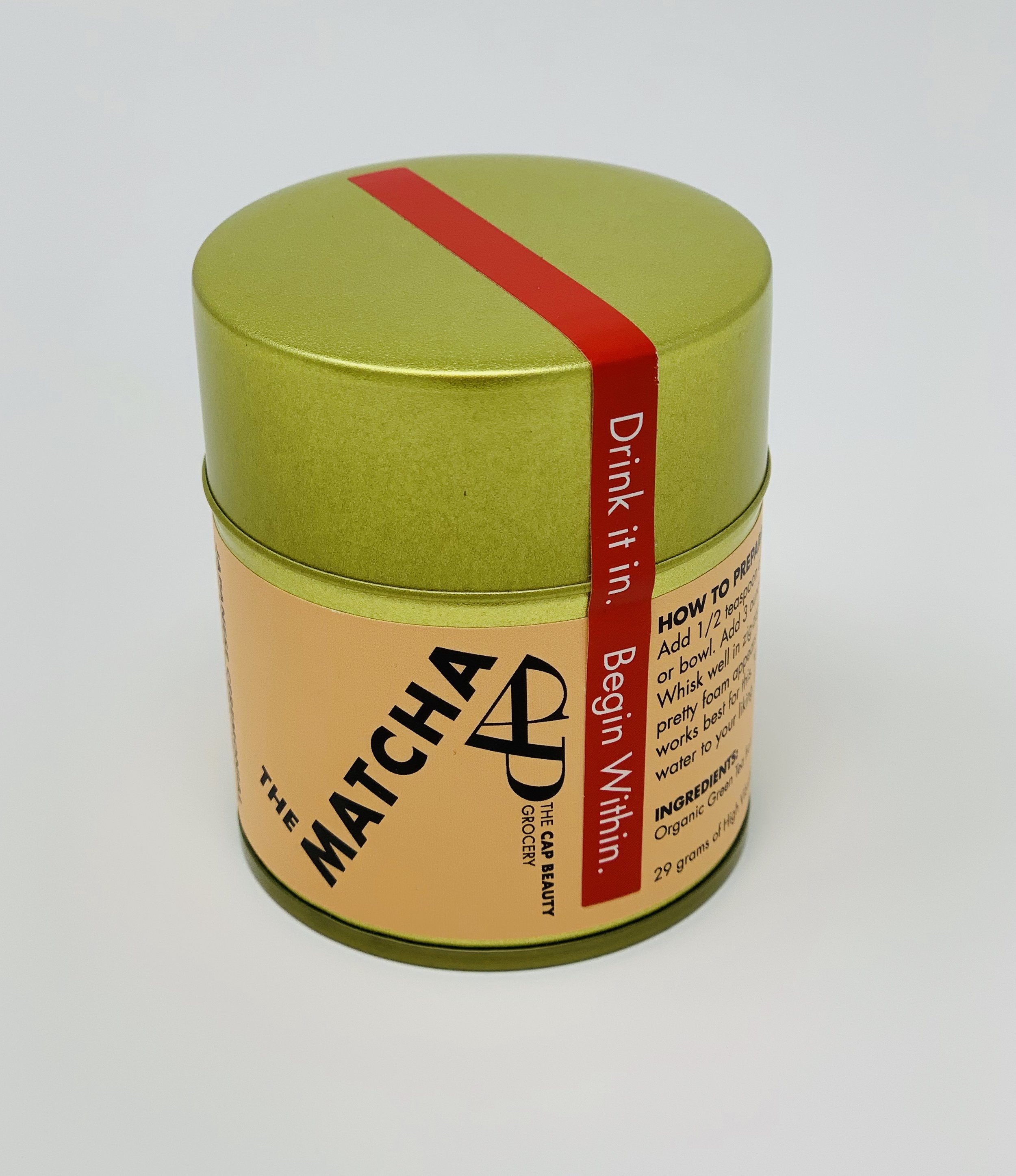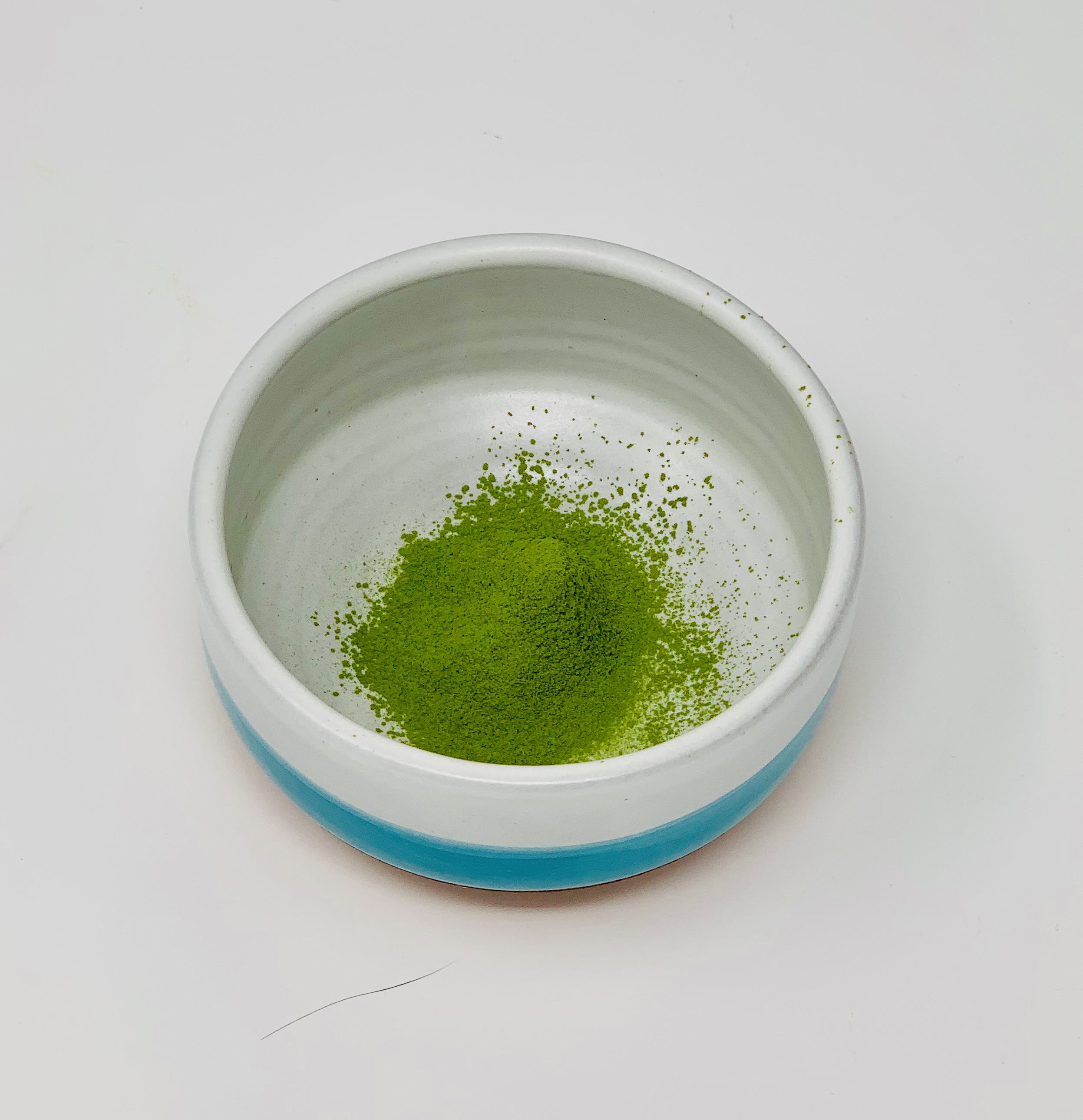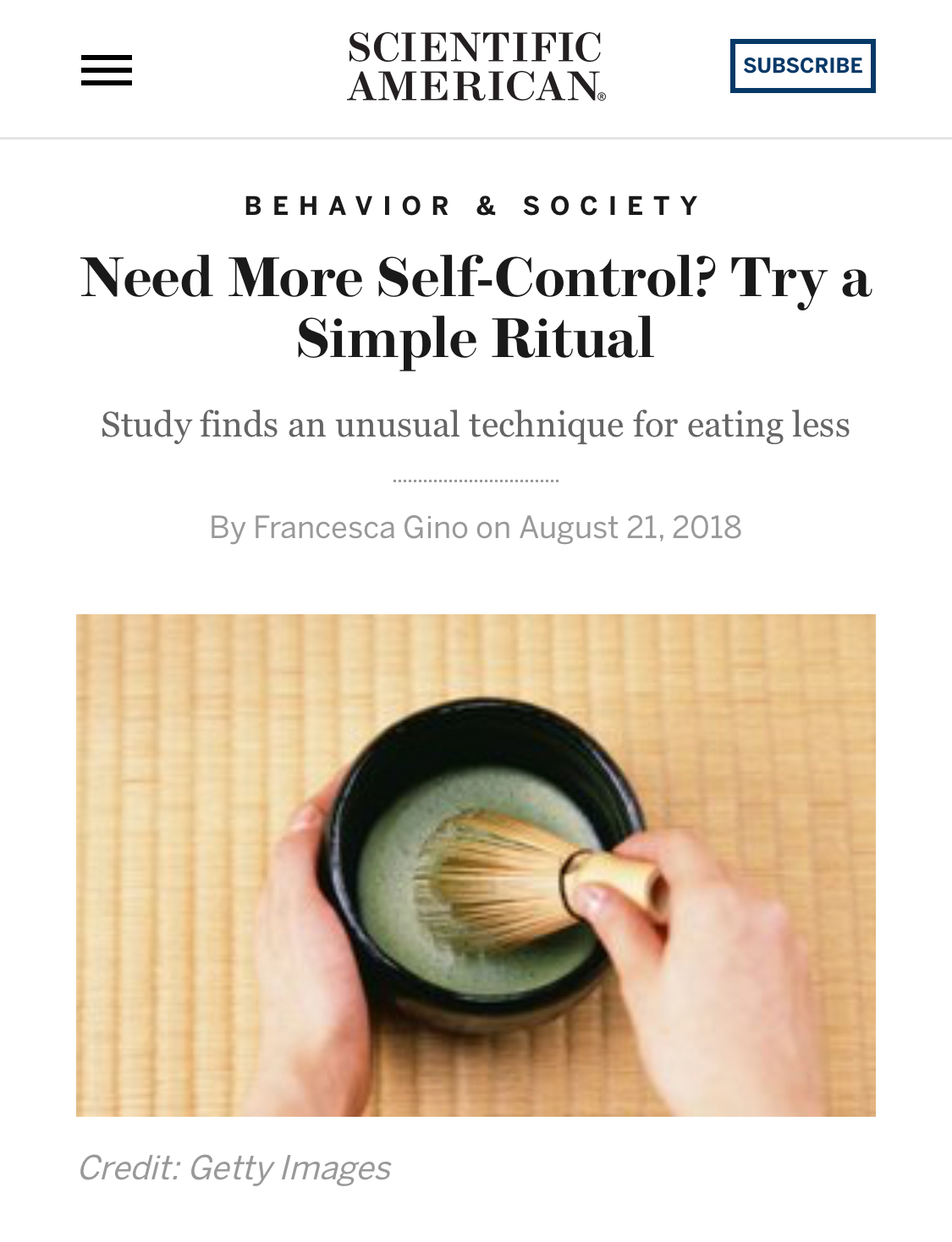
Drink it in. Begin within.
Well, my first gift for this Chanukah 2018 was perfect for me - a brand of matcha (and company) that was new to me - the organic The Matcha from CAP Beauty.
CAP Beauty is dedicated to the philosophy that “Beauty is Wellness. Wellness is Beauty” so the intent is that all their 150+ products create “true radiance.” The fact that their products are “100% natural” resonants with me, as does the recognition of plant based medicine on their website, which speaks about the power of the plants to heal, since they are “teeming with nutrition and life force.”
Of course, the label is the first thing to catch the eye, and I find it just plain uplifting, making me smile. The red label on the side of the tin says, “Drink it in. Begin within.” That accurately sums up my meditation and matcha practice - make matcha and meditate. Well, the meditation actually begins with the making of the matcha. How matcha goodness is contained within this tin - that would be “29 grams of High Vibrational Focus.” Who can argue with that?
For an organic matcha, this one is fairly good. The matcha sifts nicely, and is a lovely bright green, though not as vibrantly emerald as I have seen in many non-organic brands. My koicha whisked easily into a thick and creamy elixir, while the addition of more water to whisk an usucha produced a bowl with a thin layer of foam with sparse bubbles. The aroma was fresh and grassy. The texture was very slightly gritty, but not unpleasant at all. I did prefer the flavor profile of the koicha to the usucha, yet despite the slight bitterness common with organic matchas, this dissipated quickly to leave a umami finish that lingered for quite some time. The overall flavor was clean but not very sophisticated or complex. For an organic matcha, I readily recommend it. Once you explore their website, you might find yourself purchasing other products, as I did. I just couldn’t resist ordering their matcha coconut butter.
Need More Self-Control? Try a Simple Ritual.
A few days ago I posted a video entitled the Importance of Ritual and Matcha Making, in which I was sitting on my deck on a clear Seattle morning, capturing the my process of sifting and whisking my chawan of matcha before sitting down to meditate. Imagine my surprise when I find an email from one of my favorite magazines (sadly now only online), Scientific American Mind, declaring how any simple ritual can improve overall self-control. To add to my delight, the image was of a hand whisking a bowl of matcha. I guess science has now proven what we in the tea and matcha tribe have known all along - our daily ritual can improve our life.
One of my favorite classes to teach at Bastyr University was Myth, Ritual and Health, where we explored the power of both stories and rituals to influence, shape and heal our lives. During class, we took a closer look at our daily routines, and considered how to elevate our unconscious, mindless habits to the status of ritual, thereby infusing them with meaning and purpose. Together, the students and I soon discovered that the key is not what we do, but how we do it. For example, consider something you might do daily, like taking a shower. How do you take a shower? If you add it all the minutes, how much time have you spent bathing? And during all that time, how present were you? This, of course, begs the question, how present would you like to be in your life? Rather than mindlessly rushing through the process, you could engage fully in the moment by embracing all your senses: the feel of the water as moves across your skin, the fragrance of the soap, the texture of the towel as you dry off. Or you might meditate on gratitude: for the clean water itself, for the access to water, for the time and safety to bathe, for all those people who had a hand in ensuring that when you turned on the facet, fresh water spilled forth. Rather than viewing each activity as tasks to check off our list (a formula for stress), what if we were to have respect for every minute of our lives and honor each daily experience by showing up for ourselves in the present?
How can you add more meaning and purpose into your daily life?
Which daily habits would you like to elevate to the status of ritual?
Tea Consumption & Heart Disease - Medical News from Heart
Tea has been touted for centuries to have healing properties. As I have mentioned before in this blog, studies on the healing benefits of tea tend to focus on their polyphenol, or flavonoid, content, and more specifically the catechin epigallocatechin gallate. Unfortunately, some studies had small sample sizes or were not always replicated to verify such claims. However, on January 11, 2017, the journal, Heart, published online a study to provide more definitive data by using a larger sample size over a greater time frame. Thus from 2004 to 2013, researchers followed 199,293 men and 288,082 women from across 10 regions in China who ranged in ages from 30 - 79 years.
Drum roll please - daily tea drinking protects your heart! While the participants in this study primarily consumed green tea, previous studies have shown cardiovascular benefits from both green and non-tea consumption. Furthermore, researchers acknowledged that the chemical constituents in tea change due to processing of the various types of tea.
Regardless, the take home messages from this study were:
- People who drank tea daily showed an 8% relative risk reduction in ischemic heart disease and a 10% lower risk of major coronary events when compared to non-tea drinkers.
- The longer you have been drinking tea, the less your cardiovascular risk. Apparently, those who have been drinking tea for more than 30 years, lived in rural areas, and did not have diabetes or had normal or lower body mass index fared better.
While researchers admitted some possible limitations to the study, this large cohort followed for several years seems to support what most of use tea-aholics already know - tea is a way of life that promotes health.
Keep on whisking and steeping!
History & Health Benefits of Matcha
抹茶 - matcha
Perhaps you are new to the world of matcha, or tea, or you simply are curious and want to ask, Why matcha?
As I have written about before, I have never been a coffee drinker, despite living in the land of Starbucks where coffeehouses are found on every corner. Nor do I consume alcohol. Since starting medical school and discovering Teahouse Kuan Yin, tea is not only my favorite beverage, tea reflects a way of life. You don’t hurry with tea, you sit, you reflect, you converse, you meditate. Matcha takes this to another level.
By many accounts, the Zen Monk, Myoan Eisai/Yosai (栄西 ), commonly known as Eisai (1141 - 1251), the founder of the Rinzai sect of Zen Buddhism, is credited with the origins of matcha, although tea itself had been in Japan for quite some time before this. Born in Japan, Eisai, a Buddhist monk, grew displeased by the practices of his order, so he set off to discover new teachings in China. Upon his return from one such trip in 1191 from the Sung-dynasty in China, he brought home with him the seedlings of a new type of tea plant, Camellia sinensis, which he planted throughout the grounds of his Buddhist temple. Camellia sinensis is in the family of flowering plants called Theaceae. Camellia is the genus, or generic name, in the binomial nomenclature, while sinensis is the specific species of the plant. This can be further broken down into varieties or cultivars. A cultivar is variety of the plant reproduced asexually (cloned) to ensure the qualities and characteristics of the mother plant are maintained and pass along, which is beneficial for mass production. The most common cultivars of Camellia sinensis are sinensis and assamica. Sinensis typically refers to cultivars grown in China, Taiwan and Japan, and is smaller in stature and leaf. Assamica, on the other hand, are the cultivars traditionally found in India, which are studier and larger in size, both in height of plant and size of leaf. As any gardener knows, tending to plants is a meditative act. When Eisai took the tender leaves of his tea plants (of the sinensis cultivar), and rather than steeping them as was tradition, he ground them into a powder and added boiling water, matcha was born. The word itself, matcha, 抹茶, is derived from the words ma, which means powder, and cha, which means tea - hence, powder tea. Eisai shared his new drink with his fellow monks, extolling its healing and meditative properties, and it soon became a staple in the promotion of meditation. In 1211, he wrote his two volume book on the health benefits of tea, entitled Kissa Yojoki (喫茶養生記 ) - How to Stay Healthy by Drinking Tea. According to Eisai, Tea is the elixir of life... Tea the ultimate mental and medical and medical remedy and has the ability to make one’s life more full and complete. In 1214, Eisai presented his book to the shogun warrior, Minmoto no Sanetomo, after hearing how he was suffering from ill effects of nightly consumption of alcohol. Reading about the positive health effects of tea, and how it can reverse the effects of alcohol on the vital organs, improve mental clarity and cognitive function, and prevent fatigue, both the Shogun and Samurai soon adopted tea as part of their customs and ritual.
The matcha of Eisai's time has changed significantly compared with the matcha of today. One of the most vital steps in the matcha process is shading, which began somewhere between the 15th and 16th century as a way to prevent frost damage in the months of February and March, before the tender spouts appear. Originally the shading structures were constructed using reeds and covered with straw, but now various material are used to shade the plants from sunlight. Today, shading occurs once shoots appear, not before. For the highest grade of matcha, the tea plants must be shaded for at around three weeks. When grown in low light, chlorophyll production is stimulated, polyphenol content is reduced (responsible for the bitterness and astringency of tea) and the breakdown of the amino acid L-theanine is interrupted (which creates matcha's mellow taste), although these were not the initial reason for shading.
In early to mid-May, the first flush of young leaves are picked by hand. The leaves are first given a “light" or "shallow steam,” known as asumushi (the word mushi in Japanese means to steam) for about 15 - 20 seconds (longer steaming methods are used for other tea preparation, some lasting 90 seconds or longer). After the steaming, the leaves are dried. At this point, the leaves are called aracha, but the process is only half way complete.
Next, the veins and stems are removed from every single leaf, a methodical and labor intensive process done by hand. Dried once more, the remaining leaves are now called tencha. At this point, the tea master often tastes the tencha to ensure quality before proceeding to the final step, which involves grounding the leaves. While machines have been used by some companies to create the powder, the traditional process involves stone grounding at a very low temperature. If the process creates excessive heat, the color and chemical constituents of the tencha will be effected, and quality will be lost. The resulting powder tea, or matcha, is extremely fine, often under 10 microns. The entire process can take up to an hour to ground as little as 30 grams of matcha. Talk about a meditation practice!
These steps outline here are required for ceremonial grade matcha, which should be microfine and vibrant green in color. Numerous grades of matcha exist, yet lesser grades can contain veins and stems, could be ground at higher temperatures or might not be finely ground. These, according to purist, such as myself, are unfit for drinking, as the result leaves a bitter and astringent taste. Since matcha is sensitive to the elements, it is best stored in an airtight container and away from light, heat and air. Thus refrigeration is suggested, provided the container is firmly sealed. Furthermore, matcha is best consumed the year it was picked since it is easily degraded and oxidized by air, light, and heat.
While the health benefits of matcha are numerous, one fact about matcha that resonates with my naturopathic sensibilities is the fact that drinkers of this elixir are consuming the actual leaf. While extracts, tinctures, teas and tisanes all have healing properties and carry the energetics of the plants, I find something truly powerful about ingesting the leaf material itself. Consuming the plant material increases the health benefits. Tea contains several polyphenols, known as flavonoids, which contain antioxidants. One group of flavonoids found in tea are called flavanols, of which epigallocatechin gallate (EGCG) is often the most studied for its antioxidant properties. Of all the various catechins found in the green tea leaves, EGCG (also found in fruits, vegetables and nuts) comprises around 60% of them. A recent article in Frontiers in Endocrinology in May 2014, called Effects of Physiological Levels of the Green Tea Extract Epigallocatechin-3-Gallate on Breast Cancer cells, demonstrated that low levels of EGCG, around 1 - 7 μm (microns), was sufficient enough to not only prevented growth of breast cancer cells, it could also lead to cancer cell apoptosis (cell death). However, healthy cells were unaffected. Green tea has 2 - 3 times more EGCG and antioxidants than black tea, and matcha is significantly higher than green tea. While some people tout how matcha contains 137 times more epigallocatechin than green tea, this may erroneously be based on a 2003 study, Determination of catechins in matcha green tea by micellar electrokinetic chromatography, which compared the EGCG levels found in matcha powder with that of China Green Tip teabags from the Tazo® Company. The researchers found that Tazo® China Green Tips tea contained only 0.42 mg of EGCG / 1 gram, while matcha powder contained a whopping 57.4 mg of EGCG / 1 g of matcha. Thus matcha contained 137 times more EGCG. However, compared to other quality green teas studied matcha contained only 3 times more EGCG. Nevertheless, matcha is high in antioxidants.
L-theanine is a naturally occurring amino acid found only in tea, some forms of fungi (the mushroom Boletus badius), and one of three holly trees, Guayusa, that contain caffeine and sometimes used to make tisane. As mentioned above, the L-theanine level increases when the tea plant is grown in shaded conditions, and is responsible for the sweet, grassy, vegetal flavor, also known as umami. Unlike other forms of green tea, the L-theanine content of matcha remains very high, up to five times higher than regular sencha (20 mg compared to 4 mg). L-theanine impacts the nervous system by stimulating GABA levels, which down regulates the sympathetic, or fight or flight, system. L-theanine has also been show to increase serotonin and dopamine levels, which elevate mood and the sense of wellbeing. Since L-theanine can lead to an increase in alpha brain waves, matcha drinkers benefit from an increase in focus and concentration. Furthermore, matcha has been praised for its ability to reduce blood pressure, however, this may have more to do with the caffeine and L-theanine combination which is said to burn fat and increase immune functioning. Regardless, in some studies, drinkers of matcha have been shown to have a reduction in hypertension. Finally, matcha drinkers often do not experience the same caffeine crashes seen with coffee or other types of tea. This is due, once again, to L-theanine content. Keeping all of this in mind, no wonder Eisai suggested monks drink matcha before sitting for hours in focused silent meditation.
But when it comes right down to it, the ultimate reason I love matcha is for the experience of it. From preparing the matcha (something I will cover in another post) to savoring that intense sweet, umami flavor to the after effects of clarity of mind, matcha is a meditation in patience and presence.
Want to join me for a bowl?


















